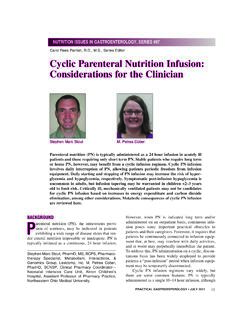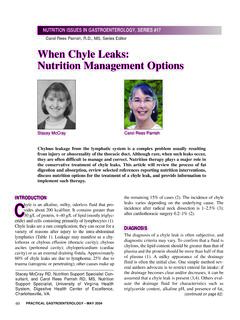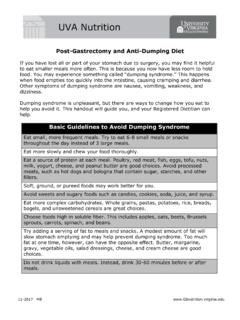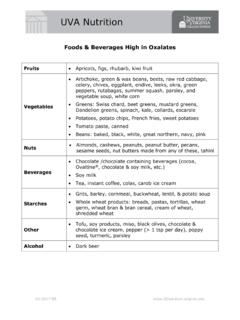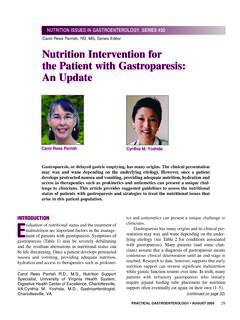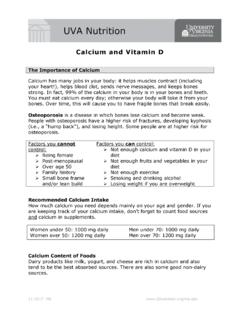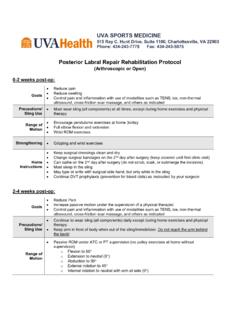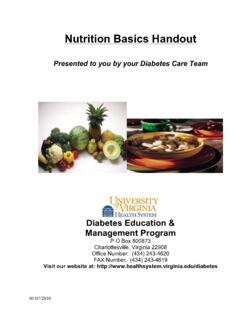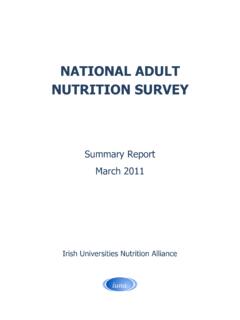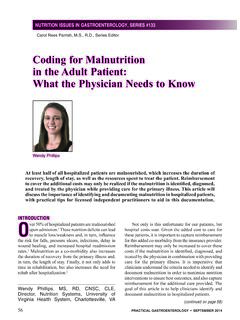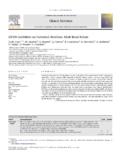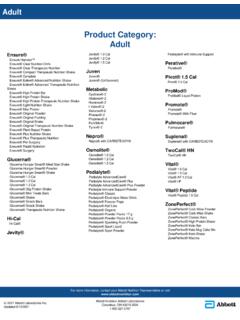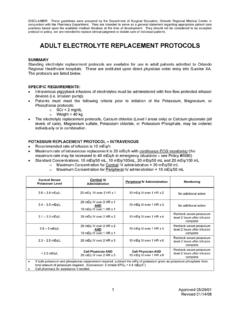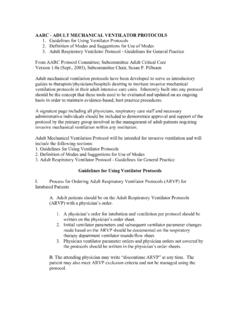Transcription of Nutrition for Patients with Hepatic Failure
1 PRACTICAL GASTROENTEROLOGY JUNE 200323 PREVALENCE OF MALNUTRITION Malnutrition is prevalent in all forms of liver dis-ease; from 20% in compensated liver disease tomore than 80% in those Patients with decom-pensated disease (1,2). Patients with alcoholic liverdisease are reported to have a greater incidence ofmalnutrition than those with nonalcoholic disease (3).Protein energy malnutrition has been reported in 100%of those who receive liver transplant, and malnutritionis an independent risk factor for morbidity and mortal-ity in these Patients (4). Frequently, Patients with end-stage Hepatic Failure will present with muscle wasting,decreased fat stores, and overt cachexia. However,many more Patients will have subtle changes such asfat-soluble vitamin deficiencies, anemia from iron,folate, and pyridoxine deficiency, altered cell-medi-ated immune function, and slow loss of muscle OF MALNUTRITION IN CHRONIC LIVER DISEASET here are a number of factors that contribute to mal- Nutrition in Patients with Hepatic Failure (Table 1).
2 Nutrition for Patients with Hepatic FailureNUTRITION ISSUES IN GASTROENTEROLOGY, SERIES #6 Series Editor: Carol Rees Parrish, , , CNSDJ oseph Krenitsky MS, RD, Nutrition Support Special-ist, University of Virginia Health System, DigestiveHealth Center of Excellence, Charlottesville, is prevalent in Patients with Hepatic Failure ; it is also an independentrisk factor for morbidity and mortality in these Patients . Factors that contribute tomalnutrition in Patients with Hepatic Failure include altered metabolic rate, fat mal-absorption, early satiety and impaired gastric emptying, as well as frequent hospital-izations and overzealous diet therapy. Providing increased Nutrition improves nitro-gen balance, increases lean body mass, and some indices of Hepatic restricting dietary protein is still practiced in some institutions, mostpatients tolerate normal, or increased, levels of protein without exacerbation ofencephalopathy when adequate medical therapy is provided.
3 The following articleaddresses strategies for the clinician to overcome some of the obstacles that preventadequate Nutrition delivery in this Krenitsky(continued on page 27)PRACTICAL GASTROENTEROLOGY JUNE 200327 Nutrition ISSUES IN GASTROENTEROLOGY, SERIES #6 Nutrition for Patients with Hepatic FailureSome of these factors are related to the disease processitself, such as ascites, causing fullness and early sati-ety. Other factors are related to frequent hospitaliza-tions, overzealous diet therapy, and hospital food. Inaddition, there are metabolic factors such as increasedmetabolic rate, fat malabsorption, and impaired glyco-gen stores that hasten the development and expressionof malnutrition in liver disease. DECREASED INTAKEI nadequate food intake is one of the primary causes ofmalnutrition and occurs in up to two-thirds of patientswith chronic liver disease.
4 Anorexia may result fromincreased circulating levels of tumor necrosis factorand leptin (5). Patients with chronic liver disease alsohave delayed gastric emptying compared to controls(6). In those Patients with ascites, early satiety andfullness are common complaints. Frequent inpatientadmissions, with periods of nothing by mouth (NPO),also contribute to decreased food ABSORPTIONR educed bile secretion due to cholestasis, or compro-mised Hepatic bile synthesis may impair micelle forma-tion, which is essential for digestion of fat by pancre-atic and luminal enzymes. The fat-soluble vitamins (A,D, E, and K) are also dependent on micelle one-third of adult Patients with chronic cholesta-sis have vitamin A deficiency, and 20 50% of adultswith primary biliary cirrhosis are deficient in vitamin D(7 9).
5 Undiagnosed pancreatic exocrine insufficiencymay be another contributing factor to altered absorptionin those Patients with alcoholic liver disease. Finally, Patients with cirrhosis have also been reported to havean increased incidence of small bowel bacterial over-growth. The prevalence of small bowel bacterial over-growth in populations with cirrhosis has been docu-mented between 35 and 60 percent of Patients (10),which may further alter nutrient absorption. ENERGY EXPENDITURE The resting energy expenditure of Patients withchronic liver disease is variable. Those Patients withacute hepatitis or advanced stages of liver Failure havean increased metabolic rate. However, hypermetabo-lism is not a constant feature of cirrhosis.
6 Approxi-mately 18% of cirrhotics have been reported withhypermetabolism, and 30% with hypometabolism(11). The mean deviation between measured and pre-dicted energy expenditure was 11%, which was lessthan 200 calories per day. ALTERED FUEL METABOLISMP atients with Hepatic Failure have accelerated starva-tion, with an early recruitment of alternative fuelsources. Cirrhotic Patients demonstrate significantlyincreased fat oxidation and gluconeogensis with proteincatabolism after an overnight fast. It would take ahealthy adult approximately 72 hours of starvation toreach the same level of fat oxidation and protein catab-olism as occurs in an overnight fast in a cirrhotic patient(12,13). It is believed that the diminished Hepatic andmuscle glycogen stores that occur with cirrhosis is a fac-tor in this accelerated rate of starvation.
7 Patients without(continued on page 30)Table 1 Etiologies of Malnutrition in CirrhosisDecreased Intake Anorexia Early satiety Ascites Altered mental status/encephalopathy Frequent hospitalizationsDecreased Absorption Inadequate bile flow Bacterial overgrowth Pancreatic insufficiencyMetabolic alterations (see Table 2)Iatrogenic Factors Overzealous dietary restrictions Frequent Paracentesis Diuresis (micronutrient losses) Lactulose therapy*Used with permission from the University of Virginia Health SystemNutrition Support Traineeship Syllabus (31)(continued from page 23)PRACTICAL GASTROENTEROLOGY JUNE 200330 Nutrition ISSUES IN GASTROENTEROLOGY, SERIES #6 Nutrition for Patients with Hepatic Failureadequate glycogen stores utilize increased fat and mus-cle protein for fuel even during short-term fasting.
8 Thiscontributes to the loss of subcutaneous fat and musclewasting that is the hallmark of malnutrition. Insulinresistance and decreased levels of insulin like growthfactor-1 are also believed to contribute to muscle wast-ing in cirrhosis. See Table 2 for a list of some of the fac-tors affecting fuel metabolism in these ASSESSMENTC onventional Nutrition assessment parameters can bemisleading when used for Patients with Hepatic weight loss is one feature that usuallyaccompanies malnutrition. However, Patients withascites frequently have substantial weight gain prior tohospitalizations, even in the presence of significantmalnutrition. It must be recognized that Patients canhave substantial loss of lean muscle weight, but main-tain or gain net body weight due to the presence ofincreasing levels of albumin and prealbumin may bealtered by a decrease in synthetic function reflecting theseverity of Hepatic impairment.
9 These same serum pro-teins may be lowered as a result of an acute-phaseresponse to a stress (GI bleed, infection, etc). Further-more, serum proteins can be severely reduced in thosewith adequate Nutrition intake, and can appear normal insome Patients with malnutrition. Dehydration can "nor-malize" serum albumin, and corticosteroid administra-tion or renal Failure can "elevate" serum prealbumin towithin normal limits in the malnourished patient. Measurement of 24-hour creatinine and triceps skin-fold with estimation of mid-upper arm muscle circum-ference, have utility for research and monitoring musclemass changes over time. They are of limited utility inmost acute care settings, and are not sensitive to short-term changes in Nutrition status.
10 A quantitative fecal fatmeasurement is helpful to identify those Patients withsteatorrhea, and the loss of fat calories that assessment of muscle mass and physi-cal signs of micronutrient deficiency upon physicalexam is useful to help estimate Nutrition status. Thosepatients with temporal muscle wasting, or obviouswasting of upper extremity muscle mass generallyrequire attention to Nutrition issues. Some Patients willpresent with the angular stomatitis, glossitis, magentatongue, or dermatitis of severe vitamin deficiency. A careful review of the patient s recent oral intakeis also a reasonable approach to assess Nutrition risk. It is important to assess both the quality and quantityof food and beverage intake. The utility of a review ofrecent oral intake is dependent upon the reliability of the patient and/or family as a with Hepatic Failure are at increased risk ofdeficiencies of several micronutrients.
